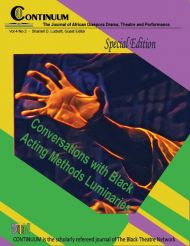Editor's Notes
Calls for Social Action in Black Theatre
Sandra G. Shannon
“When the play ends, what remains?" and "When the play ends, what begins?" This set of open-ended rhetorical questions posed by director, dramaturg and cultural critic Rustom Bharucha creates a fitting entrée to the four essays that comprise this issue of Continuum. Implicit in Bharucha’s query—which has become the cornerstone of the Theatre for Social Change movement—is an underlying dictum that theatre has a responsibility to effect change beyond the confines of the theatre space. As the essays that follow demonstrate, the beneficiaries of this change are often the powerless, the marginalized, and the misunderstood.
Shayla Atkins proves as much in her essay, “Casting Stones: The Men of Lynn Nottage’s Ruined,” which affirmsthat theater, unlike any other medium, can raise consciousness about unspeakable things unspoken, especially when politicians and elected officials fail. Timothy Lyles adopts a different approach in “Still Playin Wid Dem Barbie Dolls? Never Mind, Don’t Answer That”: Tyler Perry’s Stage as a Lonely Place for Black Queers”and takes the actor/playwright Tyler Perry to task for his seeming misuse of the stage to create what Lyles terms “a dialectic of oppression and activism” and “the double-bind faced by black queers on Perry’s stage.” In one instance, theatre serves as the vehicle for taking on issues that may be deemed too tabooed, too remote from our experiences, or too unwieldy for public airing. In the other, theatre is called into question for failing to live up to our expectations that it must facilitate rather than become an opponent of change.
Theatre that prompts social action often grows out of the community it serves and involves that community in shaping and informing the work. Macelle Mahala affirms the success of this kind of symbiotic relationship in “Neoliberalism, Gentrification, and Black Theatre in San Francisco and St. Paul.” Here, she holds up as examples of such grass root level support, the Lorraine Hansberry Theatre in San Francisco and the Penumbra Theatre Company in St. Paul, both of which have responded to shifting demographics and negotiated strategies for sustaining their organizations and their community ties. Similarly, Yoko Kurahashi demonstrates in her essay, “Celebrating the ‘Historical’ Community through Different Voices: Ping Chong and Talvin Wilks’s ‘Women of the Hill,’”how Chong and Wilks capture and re-inscribe the history of the Hill District through the voices of women of Pittsburgh’s Hill District Community.
According to Eugene Van Erven, author of Community Theatre: Global Perspectives, theatre that functions in the interest of social change—which is the inescapable calling of black theatre—operates on the cutting edge between performing arts and sociocultural intervention. To some degree, each of the essays included in this issue of Continuum seeks more than raised consciousness; they seek, instead, awareness that leads to various types of intervention and use the theatrical medium to propel it.


